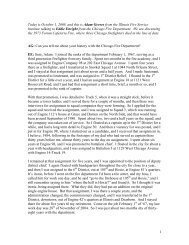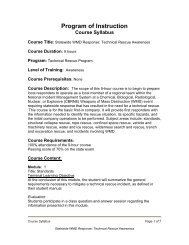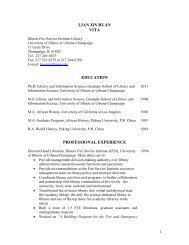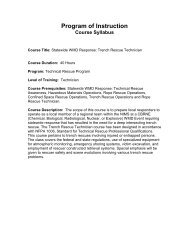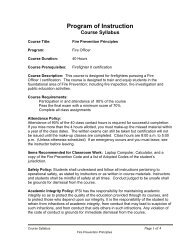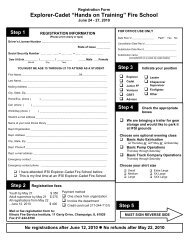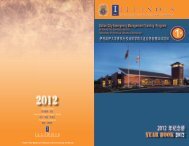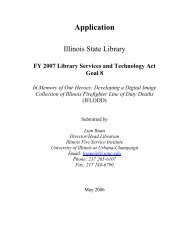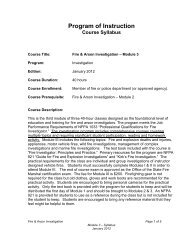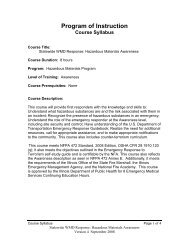CORNERSTONE PROGRAM - Illinois Fire Service Institute
CORNERSTONE PROGRAM - Illinois Fire Service Institute
CORNERSTONE PROGRAM - Illinois Fire Service Institute
- No tags were found...
You also want an ePaper? Increase the reach of your titles
YUMPU automatically turns print PDFs into web optimized ePapers that Google loves.
Popular Classes Availableat NO COST through Cornerstone<strong>Fire</strong> Fighting EssentialsEssentials 1 includes a brief classroom session witha series of hands-on instruction covering basic skills, smalltools, SCBA, ladders, hose and pumps.Essentials 2 includes “chalk talk” on building construction,plus continuing hands-on training that involves watersupply evolutions, firefighter search and rescue, advancedSCBA, hose and ladders.Essentials 3 expands upon Essentials 1 and 2 and coverscommunications, tactical priorities, plus advanced SCBAand other evolutions. The segmentsenhance cognitive and practicalskills that are part of the Essentialsprogram.Essentials 4 rounds out theprogram and requires an acquiredstructure or access to an IFSI orother Regional Training Center. Practicalskills are put to the test in evolutions that include forcibleentry, ventilation, and live smoke (this is not an acquired,structure burn).<strong>Fire</strong>ground TrainingBuilding Construction provides an understanding ofconstruction types from fire resistive materials to wood framestructural components such as windows, floor systems, rooftypes, and how these relate to suppression activities.<strong>Fire</strong> Behavior and Smoke explains how fires grow andspread, and how to recognize and anticipate what is happeningin a burning building by observing the smoke and fireconditions.<strong>Fire</strong>ground Ropes and Knots covers appropriateropes for utility applications, plus how to tie proper knots forhoisting various tools and equipment on the fireground.<strong>Fire</strong> <strong>Service</strong> Ladders works with locally-supplied laddersand covers their components,application, inspectionand maintenance. The classalso covers safe ladder carries,positioning, working from,climbing and other ladderoperations. Instructors alsodiscuss ladder components,application, inspection andmaintenance.Forcible Entry identifies various types of forcible entrysituations and locks that may be found on the fireground andhow to gain access through them.Hand Line Operations and Application focuses onnozzles, tips, patterns and required pressures, plus advancingvarious sizes of hoses into all areas of a structure.Master Stream Operations and Applicationidentifies conditions requiring master stream nozzles andsafe hose handling and operating procedures.Overhaul and Salvage covers avoiding rekindles bylearning the methods of detecting and exposing hiddenfires and protecting property.Self Contained Breathing Apparatus (SCBA)sessions teach core skills including donning, doffing,shifting, dumping, emergency procedures and buddybreathing.Ventilation class covers the advantages and disadvantagesof different types of ventilation as they relateto building construction, procedures, types of openings,roof styles and the recognition of signs of potential backdrafts and flashovers.Thermal Imaging Cameras familiarizes the studentwith the operation and departmental SOGs for camerausage.<strong>Fire</strong> Origin and Cause Awareness covers basicfire investigation and is designed to teach firefighters howto support the fire investigationprocess.<strong>Fire</strong>ground Searchand Rescue demonstratessafe, efficient search techniquesfor the routine structurefire. Rope AssistedSearch Procedures (RASP)may also be presented inthe class.<strong>Fire</strong>fighter Rehabilitationand Heat StressManagement presents the relationship between heatstress and cardiovascular strain and how this impactsfirefighter injuries and fatalities.Ethanol Awareness provides basic informationabout production, transportation and distribution ofDenatured Alcohol (E-95) and Ethanol (E-85). Since thisfuel can be found in any community, the class is recommendedfor departments regardless of whether or notthey have an ethanol plant in their community.HazMat Awareness provides first responders withthe knowledge to understand hazardous substances andthe risk associated with them in an incident. The classcovers site security and control, the need for resourcesand appropriate notifications. The end of the class examis OSFM-approved.Company Operations TrainingBasic Engine Company Operations makes the“first line in” an efficient operation by securing a watersupply, practicing hose loads and finishes, and pulling,deploying and operating appropriate lines.Basic Truck Company Operations includes ventilation,forcible entry, basic search, raising and climbingladders and other topics that are the primary responsibilitiesof truck companies.
Hydrant Supply Operations includes instruction onwater and water systems, pumps and controls, multi-linerelay operations plusmore to assure themost efficient hydrantoperations.Rural Engine andTender Operationslets responders learnhow to provide adequate fire streams in areas where littlewater exists. Students work with tender shuttles, draftingand methods for offensive and defensive fire operations.Agricultural Emergency TrainingLarge Animal Rescue Awareness (LARA) isdesigned to bring an awareness level for rescue of horses,cows, pigs, llamas and other large animals. The class coversunderstanding animal behavior in stressful settings, containmentand humane handling of animals, and much more.Anhydrous Ammonia Emergencies covers ammoniacharacteristics, environmental and health concerns, EMSoptions, as well as public and responder protection.<strong>Fire</strong>s on the Farm provides an overview of farm firesand brings strategies, tactics, operations and water supplylogistics together. The classcovers farm fires, building types,common farm chemicals, machinery,fields and/or crops.Grain Bin Rescue Awarenesswill teach students storagetypes, OSHA / IDOL regulations,as well as patient assessment,stabilization and packaging.Various cutting tools are used inthe simulated rescue.Agricultural Rescue provides principles and guidelinesfor safe responses to agricultural machinery and ag-relatedconfined space incidents. Patient packaging can also beincluded.Vehicle Rescue*Basic Auto Extrication focuses on stabilization, hazardcontrol, access, disentanglement, patient packaging andremoval of victims. Emphasis is placed on safety and properuse of tools.Advanced Auto Extrication provides more challengingpractical training with various scenarios that address“on-scene” safety, evaluation, and managing multi-vehicleaccidents.New Car Technology introducesstudents to new technologies that canimpact rescue efforts. Topics coveredinclude and drive train components,plus rescue challenges associatedwith air bags, pre-tension systems andother passive restraint devices.Large Vehicle Extricationbuilds on basic and advanced skills,providing training on large vehiclessuch as motor coaches, bussesand semitrailers.Vehicle Stabilization provides hands-on experienceon various methods to stabilize vehicles on theirside, upside down and on other vehicles or obstacles.Note: vehicles must be provided by local fire departments.*Vehicle Rescue classes may be eligible for ContinuingEducation Units (CEUs).Command and ControlBasic Company Officer outlines leadership rolesand responsibilities ranging from on-scene size-upto vehicle placement to tactical priorities to directingpeople.Basic Strategy and Tactics provides studentsan opportunity to understand the Incident CommandSystem: strategic and tactical objectives, risk management,pre-incident planning, personnel safety, plusmuch more.Leadership Principles for the <strong>Fire</strong> Officer addressesthe leadership principles necessary to effectivelydirect and manage volunteer, combination, and smallcareer departments.<strong>Fire</strong>ground Management for Small Career andVolunteer Departments is a class for all members ofa department and delivers hands-on incident managementwith an emphasis on communication skills andtactical priorities. (12 hours minimum)<strong>Fire</strong>ground Communications addresses a criticalcomponent of fireground protocols – on scene andstatus reports, plus challenging problems such as “10codes.”National <strong>Fire</strong> Academy(NFA) ClassesA number of NFA classes are availableto departments at no cost if minimumstudent enrollment is met. Talk with yourRegional Representative to learn aboutminimum enrollments and see the IFSIweb site for complete list of classes. Ourmost popular NFA class:NFA Incident Safety Officer focuseson providing students with decision-making knowledgeand skills to perform the duties of the Incident Safety Officerduring operations and training evolutions (12 hoursminimum).Courage to be Safe is designed to change theculture of accepting the loss of firefighters by sharingLine of Duty Death (LODD) survivor storiesand showing how it impacts those leftbehind. The main theme is the promotionof the strength and courage to do whatever®necessary to protect all firefighters andensure that “Everyone Goes Home.”Leadership, Accountability, Culture andKnowledge (LACK) instructs fire officers, training officersand chief officers on how “LACK” impacts firefightersafety. A special emphasis is placed on understandingfire service culture.
How do you get more from IFSI training?The <strong>Illinois</strong> <strong>Fire</strong> <strong>Service</strong> <strong>Institute</strong> employs a five-step training model that is based upon nationalbest-practices. The first step includes using many tools to do your own self-study ahead of the class.By preparing yourself ahead of time, you will get the most from the instructor-led training.Requirement for DepartmentsIt’s easy to request training for your department.A Cornerstone “Request for Training” form is required,and available from your Regional Representative, fromthe IFSI website or by contacting IFSI by phone oremail. A separate form is required for each class request.You have the option to request specific instructors,who generally will be assigned based on theirqualifications, location and availability.Once class details are finalized, the authorized representativewill be required to sign and return a Memorandumof Agreement (MOA). The signed MOA must bereturn to IFSI at least 30 days prior to start of the class.The class is then posted on the IFSI website for registration.The hosting department is expected to promote theclass to their firefighters, as well as to firefighters inother departments and emergency response organizations.There is a minimum student registration of 15at each training session to qualify for no-cost training.Your Regional Representative is available to answerquestions on minimum enrollment.Hosting a safe and successful training session. Theorganization hosting Cornerstone training agrees thatthe classes are the primary function for the scheduledclass day. Scheduling in-service companies should allowfull participation in the class.Organizations hosting the training must provide a representativeto serve as liaison with the class instructor. Thisrepresentative will assist the instructor in the coordinationof any class activities.The host organization will allow students the use of theirapparatus, equipment and appliances as may be necessaryfor the class operation. The host organization will supplytables, chairs and any A/V equipment requested by theinstructor and will make arrangements or provide access toany specialized facilities that may be needed.Requirements for StudentsStudents must submit a completed IFSI registration formto the host department prior to the scheduled class or tothe IFSI instructor on the opening day of the class. The hostdepartment and instructors are responsible for recordingattendance. Certificates of Attendance are issued for allclasses, but students must attend an entire class to receivea Certificate.All students must be able to show official affiliation witha recognized fire department or first responder organization,which provides proper insurance coverage for thestudent.Additionally, all students must be 16 years old or olderto participate in classes. Only students 18 years old or oldermay participate in hands-on training and will be required tosign an acknowledgement of hands-on conditions.



